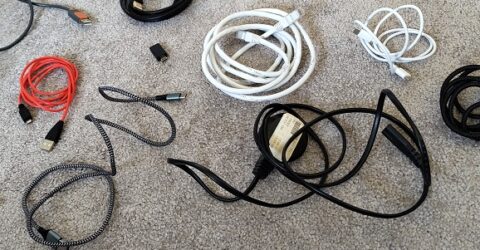A beginner’s guide to computer cables
Computer cables come in all shapes and sizes, though help is on the way courtesy of our old friends in the EU

Computers have evolved immeasurably since the Millennial days of beige boxes and floppy disc drives, yet the cables used to power and connect them have proved remarkably resilient to change.
Modern PCs and Macs are sleek affairs with brushed-aluminium cases, near-silent fans and hugely impressive CPUs and GPUs.
Yet despite the advent of wireless technologies like Bluetooth and WiFi, desktop computers still rely heavily on hardwired peripherals.
For legacy reasons, many peripherals still require connection via a bewildering array of cables, whose designations and incompatibilities have caused decades of confusion.
To shed light on the darkness behind our desktops, we’ve prepared a beginner’s guide to computer cables – their titles, job descriptions and key responsibilities.
Crucially, we also consider whether they’re likely to endure much longer, in the face of a hostile takeover from one of their own…
Cable and wireless
Chunky black power cables are drawn from the C series, from US plug-style cords (C13/14) to the two-pin (C7/8) leads used by other electronic devices like TVs and home stereos.
These were 20th century innovations, as was the ubiquitous blue VGA cable with three rows of five pins, used to connect a computer to a monitor.
Historic alternatives included the diagonal-toothed DVI connector and the five-sided Display Port cables, while printers had their own (similarly widescreen) 25-pin Parallel cables.
Smaller nine-pin Serial cables were popular in the Noughties, before cables shrank in size to support smaller connectors and faster data transfers along more efficient wiring.
Thunderbolt and Lightning
Some of the cables found on older computers were proprietary, like IBM’s colourful circular PS/2 cables which connected keyboards and mice.
Apple gave the world proprietary Firewire and Thunderbolt cables, along with the fiddly Lightning connectors which are often mated to glossy cubic plug adaptors offering next to no grip.
Other cables were developed as a global standard, including the HDMI leads now used to connect a computer to a monitor or TV set, or the enduringly popular 3.5mm audio jack.
We’ve long since abandoned RJ11 modem cables in favour of thicker (and infinitely more powerful) Ethernet leads, which can be hardwired or configured remotely via a Powerline adaptor.
Then we enter into the baffling world of Universal Serial Bus connectors.
There have been three generations of USB computer cables, with as many as four variants per generation, though some were extremely niche.
USB 2.0 Type B Mini sockets were usually found on digital cameras, while you’ve probably never seen a 3.0 B Micro with its parallel big-and-small sockets.
Type A has changed little since its debut in 1996, other than providing steadily rising data transfer speeds, while its boxy 2.0 B sibling was widely adopted by printers and scanners.
Of the latest 3.0 generation, only Types A and C have achieved significant market penetration and consumer awareness.
Now C here
We left USB-C to the end of our list because this is literally and metaphorically the future shape of connectivity.
By the end of next year, all rechargeable electronic devices sold in the EU must use a USB-C cable, which is unique among its USB relatives in being fully reversible.
(The UK has hitherto opted out of following suit, though devices sold here will probably adopt USB-C by default rather than manufacturers offering our country bespoke cabling and connectivity).
A single row of receptacle pinouts makes USB-C easier to insert and remove than any of the other cables we’ve covered, while rounded edges reduce the risk of scrapes.
Car manufacturers are replacing USB-A slots in their vehicles with Cs, though wireless smartphone mirroring means they’re mainly used to charge devices.
Laptops increasingly prioritise C sockets. This article was written on a 2022 Dell XPS laptop sporting two C ports – and nothing else.
If that sounds insufficient for powering peripherals, one of the two ports is connected to a docking station, whose merits we’ve outlined in the past.
The docking station acts as an intermediary to everything from mains power and an Ethernet socket through to connectors for speakers, a keyboard and a printer.






